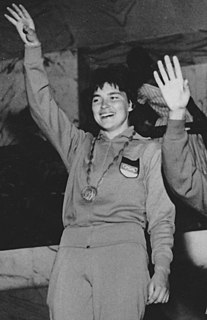
The 1960 Summer Olympics, officially known as the Games of the XVII Olympiad and commonly known as Rome 1960, were an international multi-sport event held from 25 August to 11 September 1960 in Rome, Lazio, Italy. Rome had previously been awarded the administration of the 1908 Summer Olympics, but following the eruption of Mount Vesuvius in 1906, the city had no choice but to decline and pass the honour to London. The Soviet Union won the most gold and overall medals at the 1960 Games.

EUR is a residential and business district in Rome, Italy, part of the Municipio IX.

The Capitoline Museums is a single museum containing a group of art and archaeological museums in Piazza del Campidoglio, on top of the Capitoline Hill in Rome, Italy. The historic seats of the museums are Palazzo dei Conservatori and Palazzo Nuovo, facing on the central trapezoidal piazza in a plan conceived by Michelangelo in 1536 and executed over a period of more than 400 years. The history of the museum can be traced to 1471, when Pope Sixtus IV donated a collection of important ancient bronzes to the people of Rome and located them on the Capitoline Hill. Since then, the museums' collection has grown to include many ancient Roman statues, inscriptions, and other artifacts; a collection of medieval and Renaissance art; and collections of jewels, coins, and other items. The museums are owned and operated by the municipality of Rome.

PalaLottomatica, formerly known as Palazzo dello Sport or PalaEUR, is a multi-purpose sports and entertainment arena in Rome, Italy. It is located in the heart of the well known modern EUR complex. The arena hosted the 1960 Olympic basketball tournaments.

The National Roman Museum is a museum, with several branches in separate buildings throughout the city of Rome, Italy. It shows exhibits from the pre- and early history of Rome, with a focus on archaeological findings from the period of Ancient Rome.

Adalberto Libera was one of the most representative architects of the Italian Modern movement.

The Basilica of Maxentius and Constantine, sometimes known as the Basilica Nova—meaning "new basilica"—or Basilica of Maxentius, is an ancient building in the Roman Forum, Rome, Italy. It was the largest building in the Forum, and the last Roman basilica built in the city.

Foro Italico is a sports complex in Rome, Italy, on the slopes of Monte Mario. It was built between 1928 and 1938 as the Foro Mussolini under the design of Enrico Del Debbio and, later, Luigi Moretti. Inspired by the Roman forums of the imperial age, its design is lauded as a preeminent example of Italian fascist architecture instituted by Mussolini. The purpose of the prestigious project was to get the Olympic Games of 1940 to be organised by fascist Italy and held in Rome.

The Biblioteca nazionale Vittorio Emanuele III is a national library of Italy. It occupies the eastern wing of the 18th-century Palazzo Reale in Naples, at 1 Piazza del Plebiscito, and has entrances from piazza Trieste e Trento. It is funded and organised by the Direzione Generale per i Beni Librari and the Ministero per i Beni e le Attività Culturali.

Adelheid "Heidi" Schmid is a retired German fencer who competed at the 1960, 1964 and 1968 Olympics in the individual and team foil events. She won an individual gold in 1960 and a team bronze medal in 1964.

Palazzo Valentini is a palazzo in central Rome, Italy, not far from Piazza Venezia. Since 1873 it has been the base of the provincial and prefectural administration of Rome.

The Rome Quadriennale is a foundation for the promotion of contemporary Italian art.

EUR Magliana is a railway station in Rome served by the Metro line B and the Ferrovia Roma-Lido in the EUR or Europa district of Rome. It was opened in 1924 as a Roma-Lido station for the Esposizione Universale Roma as Magliana. It was later renamed Magliana Ostiense, then Magliana again and finally its present name.
The culture of Rome in Italy refers to the arts, high culture, language, religion, politics, libraries, cuisine, architecture and fashion in Rome, Italy. Rome was supposedly founded in 753 BC and ever since has been the capital of the Roman Empire, one of the main centres of Christianity, the home of the Roman Catholic Church and the seat of the Italian Republic. Due to its historical and social importance, Rome has been nicknamed the Caput Mundi, or "capital of the world".
The men's modern pentathlon multi-sport event at the 1960 Olympic Games took place on August 26–31.
For the 1960 Summer Olympics, a total of thirty-four sports venues were used. The Basilica of Maxentius, the Baths of Caracalla, the Appian Way, and Via Cassia were among the ancient Roman venues used for the games. The football stadium in Florence hosted the 1934 FIFA World Cup and would later host the 1990 FIFA World Cup. Stadio Olimpico would later serve host to the 1987 IAAF World Championships in Athletics and the final venue for the 1990 FIFA World Cup. The marathon would be lit at night by Italian soldiers holding torches that included the Appian Way with a finish at the Arch of Constantine.

Piazza d'Aracoeli is a square of Rome (Italy), placed at the base of the Capitoline Hill, in the Rione X Campitelli.
Vincenzo Monaco was an Italian architect who collaborated with Amedeo Luccichenti from 1933 to 1963. During this period, Monaco designed more than 450 projects, of which approximately 100 were built. His work can be seen in buildings in Rome, Pisa, Naples, and Taranto, as well as in Dalmatia, Iran, France, and Tunisia.

The Circuito cittadino dell'EUR is a street circuit located in the EUR neighborhood in Rome, Italy. It is used for the Rome ePrix of the single-seater, electrically powered Formula E championship. It was first used on 14 April 2018 for the 2018 Rome ePrix.





















